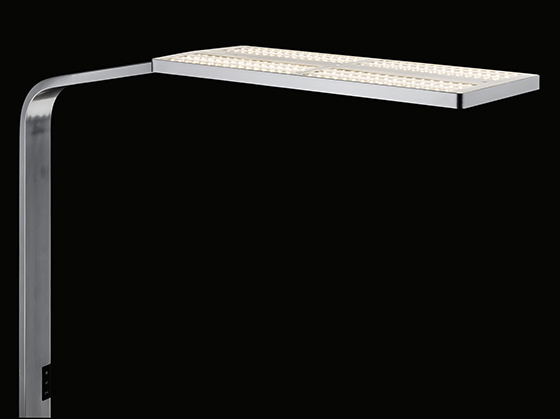Force One: Like No Other
Texte par Nimbus
Stuttgart, Allemagne
26.05.15
Force One is a powerhouse in terms of lighting properties, yet clear-cut and elegant in design. The top-class nature of this product is further underlined by the innovative light control system that allows users to set the lighting according to their individual needs at the workplace. At the same time, this floor-standing luminaire can be integrated into swarm technology and building management systems, whereby specific lighting scenarios can be controlled centrally.
The base contains the complex control systems and is discreetly positioned under the desk. Visualisation: DesignRaum
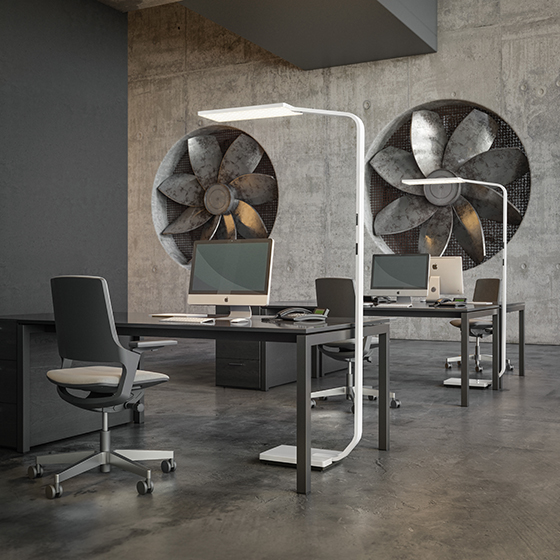
The base contains the complex control systems and is discreetly positioned under the desk. Visualisation: DesignRaum
×Force One makes it simple for users to control all facets of light – individually at the workplace or via a central building management system. Intelligent group control – swarm technology – is also possible: Force One can "communicate" wirelessly with other luminaires and form groups to enable a specific light scenario. All of these options allow lighting that can be adjusted according to need, the time of day or the time of the year or which is controlled by the movement of people approaching or leaving the workplace.
Force One also features indirect light that can be switched on and off. Photo: Frank Ockert
Irrespective of any central control system, Force One gives the user plenty of leeway for individual settings: it is equipped with indirect light that can be switched on and off. If the Power version is used, further lighting around the workplace becomes superfluous when the surroundings and light conditions allow– Force One is an efficient luminaire that, in Power mode, emits up to 8,000 lumens on its solitary mission to light up the workplace.
Force One can be operated individually using two touch-sensitive control panels flush-mounted in the profile of the luminaire. This workplace luminaire can also be controlled using swarm technology or building management systems. Photo: Frank Ockert

Force One can be operated individually using two touch-sensitive control panels flush-mounted in the profile of the luminaire. This workplace luminaire can also be controlled using swarm technology or building management systems. Photo: Frank Ockert
×Two integrated capacitive - in other words touch-sensitive - switching units flush mounted in the luminaire profile allow convenient control; these can also be used to activate the PDLS.next presence detection and ambient light sensor.
Perfectly suited to executive offices: Force One makes a slender and distinguished impression at the workplace. The light system is complex but easy to control for individual luminaires. Visualisation: DesignRaum
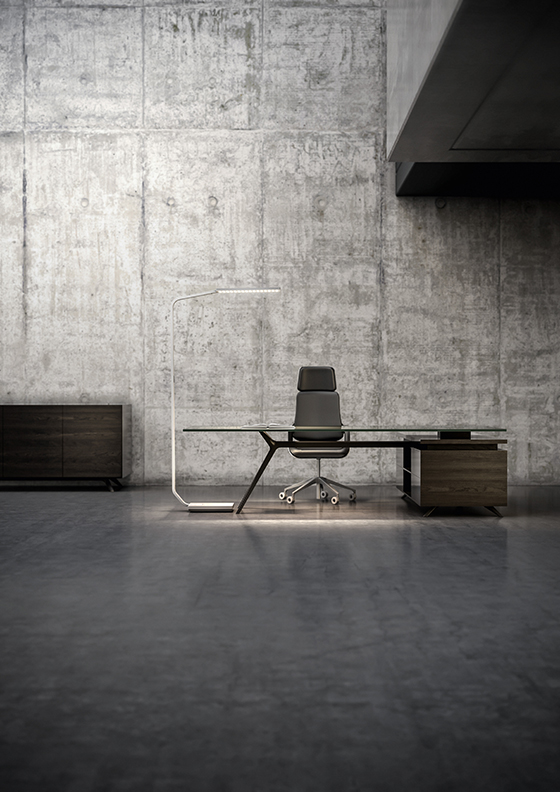
Perfectly suited to executive offices: Force One makes a slender and distinguished impression at the workplace. The light system is complex but easy to control for individual luminaires. Visualisation: DesignRaum
×The design unites a technical look-and-feel with a playful airiness. Rupert Kopp, the designer of Force One, speaks of a "dynamic and, at the same time, calm and tidy impression in an office situation." Nimbus founder and CEO Dietrich F. Brennenstuhl adds: "LED technology is the perfect means for realising our design philosophy: leave out whatever is unnecessary and concentrate on what a luminaire needs to work well." In line with these principles, further refinements have been made to the diffuser that is so characteristic for all Nimbus LED luminaires with its conical indentations for suppressing glare and directing the light. Force One has been equipped with an optimised Softlight Diffuser made of high-quality polycarbonate. It emits a soft light and forms a harmonious entity together with the other luminaire components.
The Berlin product designer Rupert Kopp (right) in discussion with Moritz Merkel, product developer at the Nimbus Group. Photo: Frank Ockert
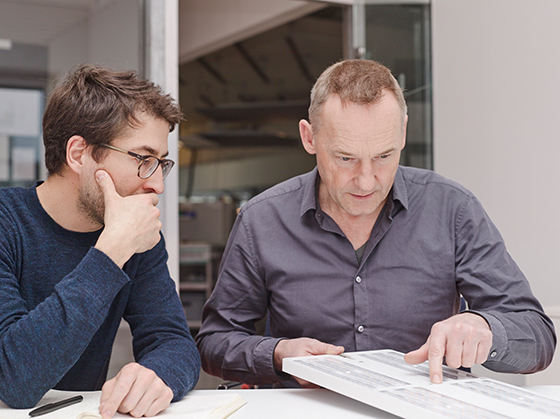
The Berlin product designer Rupert Kopp (right) in discussion with Moritz Merkel, product developer at the Nimbus Group. Photo: Frank Ockert
×Rupert Kopp's design studio is located in Berlin-Kreuzberg, just a stone's throw away from the River Spree. This is where he developed the design for a workplace luminaire like there has never been before. Its name is just as distinctive as its form: Force One. When you see and use it for the first time, everything about it gives the impression of being perfectly thought out; every detail is logical and its clear-cut form makes perfect sense. If you mention this impression to Rupert Kopp, he can't help but smile: "Such an impression is always the number one aim for me as a designer. Everything should be so self-evident that the potential user is immediately impressed and the product can be used intuitively. But the way to achieve such a design is not always as easy as it may appear." And there were indeed a number of obstacles to overcome throughout the several years of development. These did not have so much to do with the thing as whole, with basic concept, but rather with the challenge of making the luminaire manufacturable in just the way that was wanted and in accordance with the highest quality standards.
Functional test of the luminaire head in the assembly department in Stuttgart. Photo: Gordon Koelmel
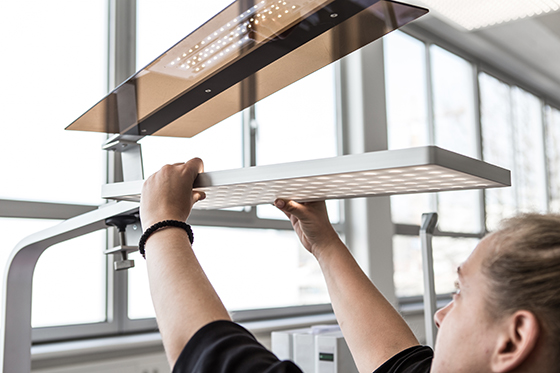
Functional test of the luminaire head in the assembly department in Stuttgart. Photo: Gordon Koelmel
×For example, the elongated support element from the head to the base of the Force One, that is to say the actual backbone of the floor-standing luminaire, has subtle radii: a soft radius on the outer side and a more sharply defined radius in the inside. This meant that a manufacturer had to be found that was in a position to realise the bend just as Rupert Kopp had envisioned. It is a fact that the more simple a product design appears to be, the more important it is to get the fine details rights – and to ensure meticulous processing. It is often a question of millimetres, a gradual process until the ultimate form and structure is determined.
The details and silhouette of the Force One undoubtedly possess an elegance that lend it an aesthetic quality as an object in space from whatever angle it is regarded. Rupert Kopp: "To me, a floor-standing luminaire for the workplace is a sculpture equipped with functions – and I consider both of these aspects to be extremely important: the ideal characteristics as an object of daily use but also its sculptural design, its aesthetic dimension."
Product designer Rupert Kopp still uses a pencil to put his initial ideas down on paper. Drawing: Rupert Kopp
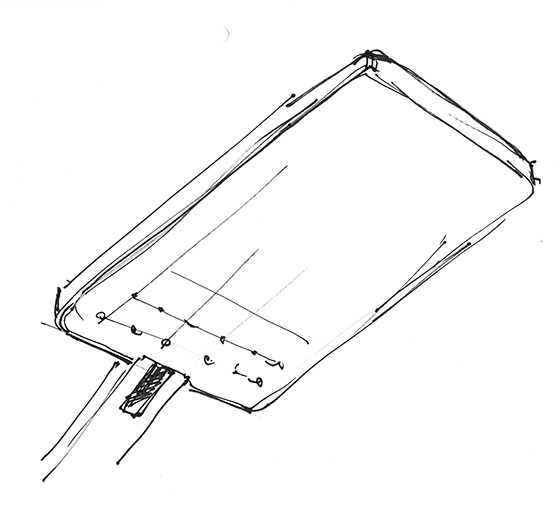
Product designer Rupert Kopp still uses a pencil to put his initial ideas down on paper. Drawing: Rupert Kopp
×He relies on a classical design method within the form-finding process: Rupert Kopp still uses a pencil to put down his initial ideas on paper, then, when a form has manifested itself, he changes over to digital rendering programs to give a 3D visual impression of a product by means of models in various stages and degrees of detail.
The decisive innovations with Force One may not be quite so obvious at first glance. However, they become very apparent when the luminaire is used on a daily basis: its head projects an unusually long way across the table's work surface and its base disappears completely under the table, thereby eliminating the risk of tripping. This was achieved by placing the required technical units in the base of the luminaire rather than in the head, as would normally be the case. This meant that the weight could be shifted to where it can be effectively exploited for the purpose of stabilisation and it was then possible to give the head of the luminaire an extremely graceful design while introducing significant optimisation in terms of its surface and luminous effect. There were also other demanding technical challenges that had to be mastered: thanks to a new type of plug-in connection, Force One can be installed quickly and easily and it boasts an especially developed, perfectly flicker-free dimming system – engineered design by Nimbus, made in Stuttgart.
Assembly of the Force One: volume production at Nimbus is based on the criteria of intelligent and highly efficient lean production. Photo: Gordon Koelmel

Assembly of the Force One: volume production at Nimbus is based on the criteria of intelligent and highly efficient lean production. Photo: Gordon Koelmel
×Volume production of the Force One at the Nimbus Group in Stuttgart-Feuerbach is based on lean production criteria. Nimbus established a special production area with synchronised manufacturing in close collaboration with Porsche Consulting – with strictly structured processes and perfectly coordinated assembly teams.
The benefits: less waste of time and labour as well as an enormous increase in flexibility. On the one hand, Nimbus is now able to produce large quantities in a shorter time and, on the other hand, the enterprise can also produce customised luminaires and small series economically. This was the spirit that gave birth to the Force One, a floor-standing workplace luminaire unlike any offered by any other manufacturer: it illuminates the work space evenly and over an unusually wide area. Dietrich F. Brennenstuhl, founder and CEO of the Nimbus Group: "We make the best possible use of the properties that only LEDs can offer: they give off little heat, are glare-free at the height we have chosen and, as far as the weight is concerned, they are the ideal choice for generating a good working light even in this elongated, trapezium-shaped arrangement."
....


